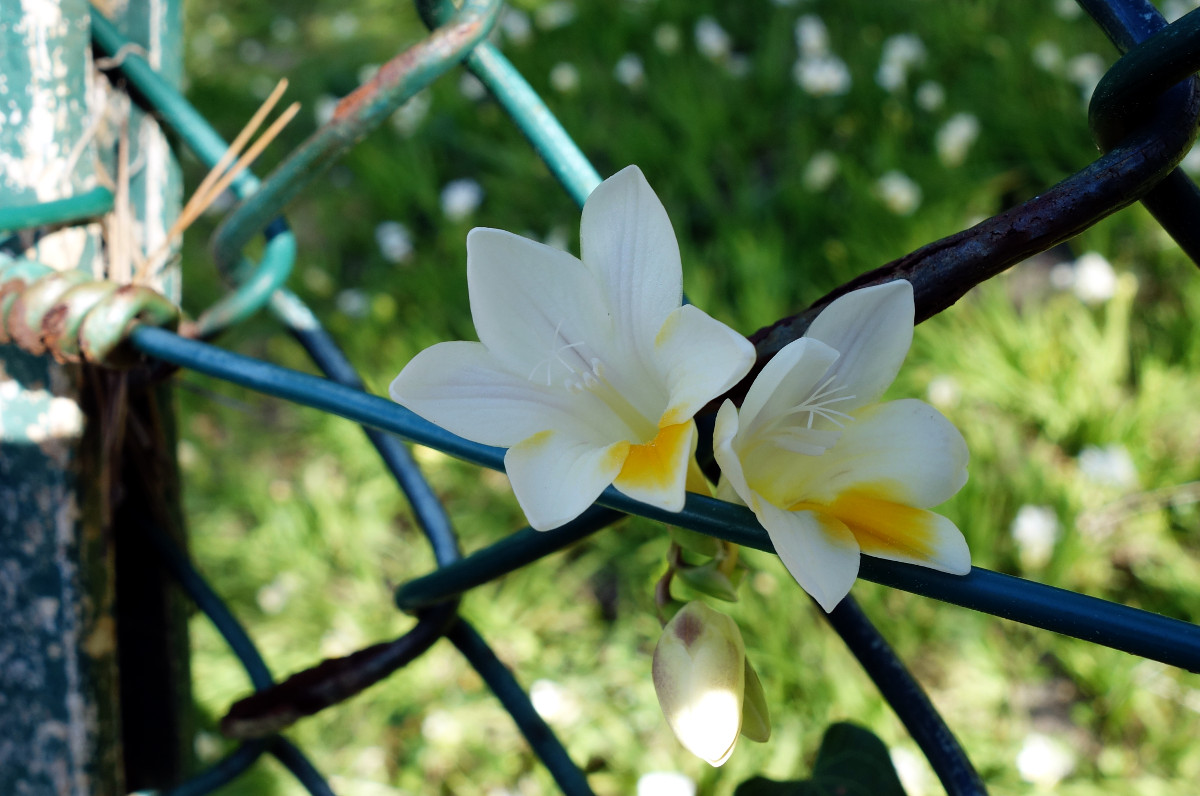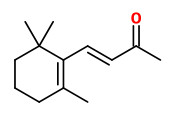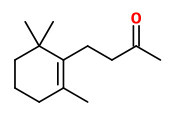Freesia spec. (Freesia refracta (Jacquin) Klatt and related species) - syn.Anomatheca spec. - Iridaceae - freesia, Freesie
Perennial herbs, up to 40cm high, native to southern Africa, naturalized and cultivated elsewhere; flowers in one-sided spikes, various colors. „The plants commonly known as „freesias“, with fragrant funnel-shaped flowers, are cultivated hybrids of a number of Freesia species. Some other species are also grown as ornamental plants.“
http://en.wikipedia.org/wiki/Freesia
The major components of a steam-distilled solvent extract (n-hexane) of Freesia × hybrida flowers were linalool (68%) and α-terpineol (19%). Fresh green notes are added by 2-hexanol, 3-hexanol, (E)-2-hexenol, (Z)-3-hexenol, (Z)-3-hexenyl acetate (sweet-green) and traces of 2-isopropyl-3-methoxypyrazine (pea-green). Small amounts of terpinen-4-ol, nerol, geraniol, geranial, γ-nonalactone and eugenol were present. α-Ionone (0.1%) and β-ionone (0.28%) provide violet nuances.
[The volatile constituents of freesia flower (Freesia hybrida Hort.)., Harada, K., Mihara, S., Agricultural and biological chemistry, Vol.48(11), 1984, 2843-2845]
http://www.tandfonline.com/doi/pdf/10.1080/00021369.1984.10866599
Main components of the headspace of living Freesia flowers were linalool (78.0%), 4-oxo-β-ionone (5.4%), α-terpineol (4.0%), dihydro-β-ionone (3.7%), β-ionone (3.0%), 4-oxo-β-ionol (2.2%), the linalool oxides (1.0%), 3-hexenyl butyrate (0.2%), nerol/geraniol (0.2%), and β-cyclocitral (0.1%).
[Mookherjee BD et al., „Fruits and Flowers: Live vs Dead - Which do we want?“, in: Nishimura, O. „Flavors and Fragrances, a world perspective.“ Proceedings of the 10th international congress of essential oils, fragrances and flavors, Washington, DC. Vol. 375. 1986, 415-424]
„Yellow-flowered cultivars such as ‘Gold Flame’, ‘Rijnveld’s Golden Yellow’ and ‘Aladdin’ emitted volatile compounds [collected by dynamic headspace analysis] abundantly, while ‘Rose Marie’, ‘Blue Heaven’ and ‘Volcano’ showed hardly any emission. A total of 16 volatile compounds were identified. Linalool, which accounted for at least one third of the total peak area, was the dominant volatile compound common to the species and cultivars other than F. caryophyllacea, F. refracta and ‘Evita’. Freesia species and cultivars were separated into three groups based on the composition of these volatile compounds. In Group I linalool was the dominant volatile compound. This group was further separated into three subgroups; In Subgroup I-i, which included three species (F. alba, F. corymbosa and F. elimensis), and six cultivars, fragrance was dominated by only linalool. In Subgroup I-ii, which included two species (F. fergusoniae and F. leichtlinii) and five cultivars, flowers had sweet fragrance comprised mainly of linalool and some other related monoterpenoids. In Subgroup I-iii, which included two cultivars, fragrance was characterized by limonene, ocimene and α-terpinolene, as well as linalool. In Group II, fragrance was dominated by linalool, 2-phenylethyl acetate and benzyl alcohol, and this group included F. occidentalis and ‘Rose Marie’. In Group III, which included F. caryophyllacea and ‘Evita’, fragrance was dominated by terpinolene. ‘Gold Flame’, F. sparrmannii and F. refracta were outgroups having a characteristic scent.“
[Analysis of flower scent of freesia species and cultivars., Wongchaochant, S., Inamoto, K., Doi, M., In IX International Symposium on Flower Bulbs 673, 2004, 595-601]
http://wwwlib.teiep.gr/images/stories/acta/Acta%20673/673_82.pdf
„The scent from the „Yvonne“ and „Versatile“ varieties of the Freesia × hybrida flowers contains up to 87.5% monoterpenes and sesquiterpenes, and small quantities of benzene compounds (0.45-3.76% of identified substances) and hydrocarbons (0.13-0.43% of identified substances). Only 4 substances, from the indentified was present in both Freesia hybrids, in both years (2010 and 2011): linalool, α-terpineol, nerol and geraniol. The share is owned by linalool which is about 53.47-82.43% from the total indentified compounds from the both Freesia hybrids, and the α-terpineol was 1.20-17.08% from the total indentified compounds.“
[Contribution to knowledge the volatile oil from Freesia× hybrida lowers,„ Yvonne“ and„ Versailles“ variety., Dulgheru, C., Burzo, I., Lucrări Ştiinţifice-Universitatea de Ştiinţe Agronomice şi Medicină Veterinară Bucureşti. Seria B, Horticultură, Vol.(55), 2011, 628-631]
The scent of Freesia cultivars as most successful ornamentals of the flower trade is dominated by linalool, α-terpineol, β-ionone, and dihydro-β-ionone. These compounds are common and widespread in flowering plants, emphasizing the importance of particular combinations of compounds in producing distinct scent accords. The strong ionone-floral scent of yellow-flowered Freesia is generated by β-ionone and dihydro-β-ionone, blended with the typical piney-floral α-terpineol or the floral-woody note of linalool. F.refracta and F.viridis deviate significantly from this accords with their deep rosy-floral scent due to citronellol, nerol, geraniol, and the lemony shade of citral. The mild floral-woody scent of F.andersoniae and F.corymbosa is typical due to high levels of linalool (92.0%/66.5%).
[Scent of a vanishing flora, Roman Kaiser, 2011, 117-125 (including GC fig.), 358-362 (GC tab.)]
The flower volatile compounds of two pleasant and strong fragrant tetraploid Freesia × hybrida (pink-yellow and yellow) cultivars and their cut flowers were analysed by headspace solid-phase microextraction combined with GC. Linalool was the major compound in both cultivars. The uncut pink-yellow one emitted mainly linalool (96.3%), further compounds were present below 0.6% resp., like naphtalene, 2-methyl naphtalene, decanal, eucarvone, nerol, 2,6-dimethyl-undecane, 2,6,10-trimethyl-dodecane, farnesene, ionone, gurjunene, and ethyl hexadecanoate.
The yellow cultivar emitted linalool (68.0%) and terpineol (11.8%). Minor components were monoterpenoids like pinene, phellandrene, myrcene, eucalyptol, limonene, terpinene, terpinolene, nerol and geraniol, as well as the olfactory important dihydroionone (3.0%) and ionone (2.5%).
Volatiles of the cut flowers were very similar to that of the un-cut flowers.
[Volatile compound in cut and un-cut flowers of tetraploid Freesia hybrida., Ao, M., Liu, B., Wang, L., Natural product research, vol.27(1), 2013, 37-40] http://ir.ciac.jl.cn/bitstream/322003/50412/2/1257.pdf

Freesia refracta (Jacq.) Klatt [as Gladiolus refractus Jacq.]
Redouté, P.J., Les Liliacées, vol. 7: t. 419 (1805-1816) [P.J. Redouté]
http://www.plantillustrations.org/species.php?id_species=444599

Freesia flowers, Author: Andreas Kraska, CC BY-SA 3.0




